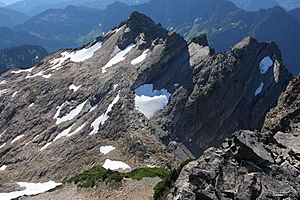Gothic Peak (Washington) facts for kids
Quick facts for kids Gothic Peak |
|
|---|---|

Gothic Peak and Foggy Lake
|
|
| Highest point | |
| Elevation | 6,213 ft (1,894 m) |
| Prominence | 693 ft (211 m) |
| Geography | |
| Location | Snohomish County, Washington, U.S. |
| Parent range | North Cascades Cascade Range |
| Topo map | USGS Monte Cristo |
| Type of rock | Sandstone, Quartz diorite, Conglomerate-Argillite |
| Climbing | |
| First ascent | 1934 by Don Blair, Willard Carr, Norval Grigg, Art Winder |
| Easiest route | Scrambling class 3 North slope |
Gothic Peak is a tall mountain in Washington state. It stands about 6,213-foot (1,894-metre) high. You can find it in Snohomish County, near the western edge of the North Cascades mountain range.
The mountain is located south of Barlow Pass, along the Mountain Loop Highway. It's close to the Monte Cristo area. The land around Gothic Peak is managed by the Mount Baker-Snoqualmie National Forest.
Gothic Peak was named after an early gold seeker, William Gothic. He was one of the first people to claim land in the area known as Gothic Basin. The mountain's name became official in 1967.
The closest taller mountain is Del Campo Peak, which is about 0.5 miles (0.80 km) to the northeast. A lower area called Foggy Pass sits between these two peaks. Below the east side of Gothic Peak, you'll find Foggy Lake in Gothic Basin. Water from this lake flows into the South Fork Sauk River. Water from the west side of the mountain flows into the Sultan River.
The first people to climb Gothic Peak were Don Blair, Willard Carr, Norval Grigg, and Art Winder. They reached the top on June 10, 1934. If you want to climb this mountain, the best time to go is usually from July through September, when the weather is nicer.
Mountain Weather and Climate
Gothic Peak is in a part of western North America that has a wet and mild climate. This means it gets a lot of rain and snow. Most of the weather systems start over the Pacific Ocean. They then move northeast towards the Cascade Mountains.
When these weather systems reach the North Cascades, the tall peaks force the air to rise. As the air goes higher, it cools down and drops its moisture. This causes a lot of rain or snowfall on the western side of the mountains. This effect is called Orographic lift.
Because of this, the western side of the North Cascades gets a lot of precipitation, especially snow in the winter. The climate here is mild, so temperatures rarely go below 0 °F (−18 °C) (freezing) or above 80 °F (27 °C) (hot).
In winter, the weather is often cloudy. But during the summer, high pressure systems over the Pacific Ocean often bring clear skies. The snow in this area tends to be wet and heavy. This can sometimes lead to a high risk of avalanches.
How Gothic Peak Was Formed
The North Cascades mountains have very rugged and dramatic shapes. You can see jagged peaks, sharp ridges, and deep valleys carved by glaciers. These amazing shapes and the big changes in elevation were created by geological events that happened millions of years ago.
The Cascade Range began to form a very long time ago, during the late Eocene Epoch. This was when the North American Plate slowly moved over the Pacific Plate. This movement caused many volcanic eruptions and other geological activity.
Also, small pieces of the Earth's crust, called terranes, came together to form the North Cascades about 50 million years ago.
Later, during the Pleistocene period (which started over two million years ago), glaciers played a huge role. These massive ice sheets moved forward and backward many times. As they moved, they scraped and shaped the land, leaving behind rock debris. The "U"-shaped valleys you see today were formed by these glaciers.
The combination of the land pushing upwards (uplift) and cracks in the Earth's crust (faulting), along with the powerful action of glaciers, created the tall peaks and deep valleys of the North Cascades.
Images for kids






